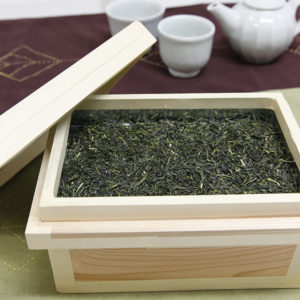
Chabako (茶箱) means tea box.
There are two types: the chabako used in the tea ceremony to carry the utensils, and the one used for storage and transportation of tea.
In this post we’ll focus on the latter.
These tea boxes are good at preventing humidity and insects from damaging the tea.
The most common place to find chabako is at some tea wholesalers in Japan.
History of chabako
While tea boxes have a long history, chabako began to take its modern form in the Edo period.
This happened because Japan started to export tea.
Shizuoka prefecture became an important tea producer and it was there where chabako for tea export were developed.
The chosen material was cedar wood. At the time there was a nearby mountain where this wood could be obtained, and it proved to have a good moisture controlling property.
At first, a method to further protect the tea from moisture involved using a paper treated with astringent persimmon juice for the inside of the box.
Later on, a zinc or tin plate was used instead. Nowadays it is a galvanized metal sheet.
Another important aspect of chabako is that the lid is made in such a way that the box becomes airtight when closed.
Chabako in modern times
Unfortunately, the chabako isn’t widely used anymore because better methods of packaging have been invented.
But when I visited Shizuoka some years ago they were still being used by some tea wholesalers, as you can see in the picture.
There are just a handful of companies left that still produce chabako.
Nevertheless, some people have been using them to store other things at home such as rice, vegetables and even clothes.
Sometimes it is used as an interior design item.
I would love to have my own chabako at home!
Here’s a video showing how chabako are made:





